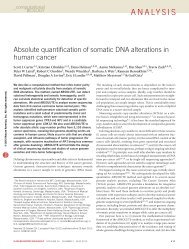Poster Session I (PI 1-106)Displayed 8:00 am – 3:00 ... - Nature
Poster Session I (PI 1-106)Displayed 8:00 am – 3:00 ... - Nature
Poster Session I (PI 1-106)Displayed 8:00 am – 3:00 ... - Nature
You also want an ePaper? Increase the reach of your titles
YUMPU automatically turns print PDFs into web optimized ePapers that Google loves.
aBsTraCTs nature publishing group<br />
and expression of the GGT-pathway genes Ggt1, Anpep and Ccbl1<br />
was unaffected. KEGG pathway analyses on kidneys from treated<br />
mice revealed that the most significantly altered genes were associated<br />
with the p53 signaling network, including Cdnk1a and Mdm2, both in<br />
wild type mice (P=2.40×10 -11 ) and Oct1/2(-/-) mice (P=1.92×10 -8 ).<br />
The significance of this pathway was confirmed in subsequent experiments<br />
demonstrating that even heterozygosity for a p53-null allele<br />
already resulted in <strong>am</strong>elioration of cisplatin nephrotoxicity. Furthermore,<br />
administration of pifithrin-α, an inhibitor of p53-dependent transcriptional<br />
activation, decreased cisplatin-induced kidney d<strong>am</strong>age in<br />
Oct1/2(-/-) mice compared to vehicle control.<br />
CONCLUSION: These findings indicate that (i) the p53 pathway<br />
plays a crucial role in response to cisplatin treatment and (ii) clinical<br />
exploration of OCT2 inhibitors may not lead to complete nephroprotection<br />
unless this pathway is simultaneously attacked.<br />
<strong>PI</strong>-43<br />
CONTRIBUTION OF METABOLISM TO SORAFENIB PHAR-<br />
MACOKINETIC VARIABILITY. E. I. Zimmerman, J. L. Roberts,<br />
L. Li, A. Gibson, J. E. Rubnitz, H. Inaba, S. D. Baker; St. Jude Children’s<br />
Research Hospital, Memphis, TN. E.I. Zimmerman: None.<br />
J.L. Roberts: None. L. Li: None. A. Gibson: None. J.E. Rubnitz:<br />
None. H. Inaba: 6. I will be discussing the following product, which<br />
is not labeled for the use under discussion, or the product is still investigational;<br />
Company/Drug; Bayer Pharmaceuticals/sorafenib, Onyx<br />
Pharmaceuticals/sorafenib. S.D. Baker: None.<br />
BACKGROUND: Sorafenib is a multikinase inhibitor currently<br />
under clinical investigation for the treatment of acute myeloid<br />
leukemia (AML). The purpose of our study was to characterize sorafenib<br />
metabolism in pediatric AML patients and determine the UDPglucuronosyltransferase<br />
(UGT) and cytochrome P450 (CYP) enzymes<br />
involved in sorafenib metabolism.<br />
METHODS: Sorafenib was administered (150 or 2<strong>00</strong> mg/m 2 twice<br />
daily) and PK s<strong>am</strong>pling was performed at steady-state. Sorafenib<br />
metabolism was assessed in vitro using human liver microsomes and<br />
recombinant UGT and CYP isozymes. The effect of azole antifungals<br />
on sorafenib metabolism by UGT1A9 and CYP3A4 was determined<br />
in vitro. Sorafenib and metabolites were measured in human plasma<br />
and in vitro metabolic reaction mixtures by LC-MS/MS.<br />
RESULTS: In 22 children with AML (14 males; median age, 9 yr<br />
[range, 1-17 yr]), the median (range) conversion rate of sorafenib to<br />
sorafenib N-oxide, an active metabolite, was 20% (5.2%-69%). Notably,<br />
metabolism to N-oxide was highest (> 30%) in males aged 5-10 yr.<br />
Sorafenib was predominantly metabolized by UGT1A9 to sorafenib<br />
glucuronide (Km = 3.6 μM) and by CYP3A4 to the N-oxide (Km =<br />
12 μM, Vmax = 3.1 nmol/min/nmol). Ketoconazole inhibited sorafenib<br />
metabolism by UGT1A9 (Ki = 2.2 μM), while ketoconazole, posaconazole<br />
and voriconazole inhibited CYP3A4-mediated metabolism<br />
(Ki = 0.17, 0.38, and 39 μM, respectively). Patients receiving concurrent<br />
voriconazole or posaconazole had the lowest sorafenib N-oxide<br />
conversion rates to the N-oxide (








